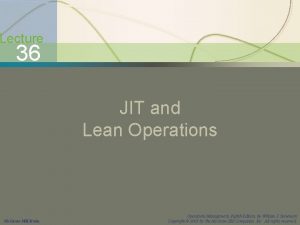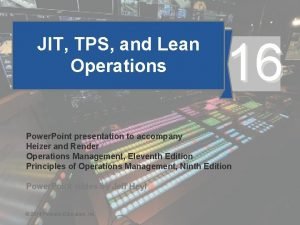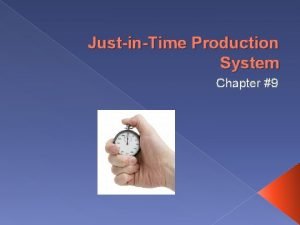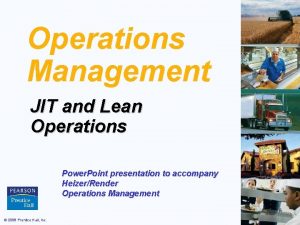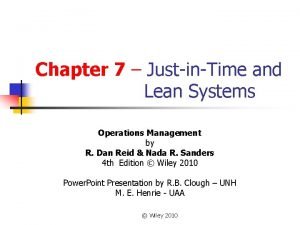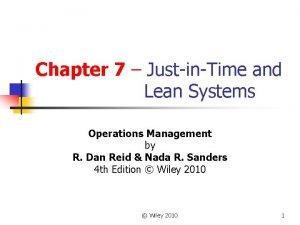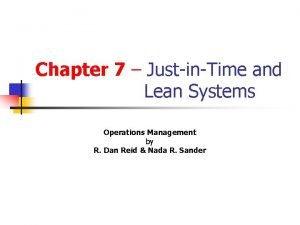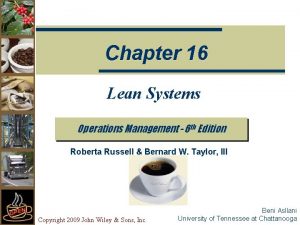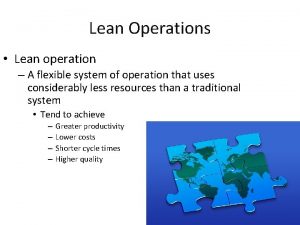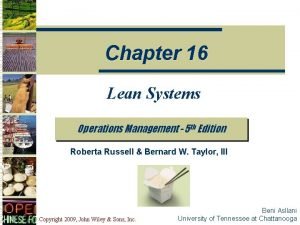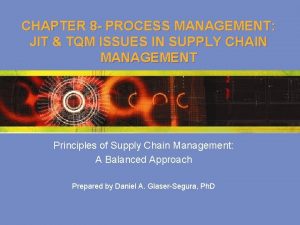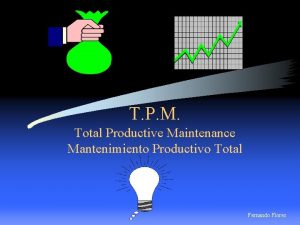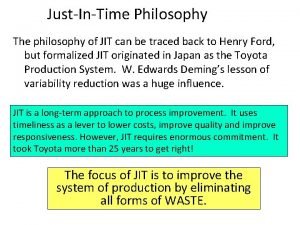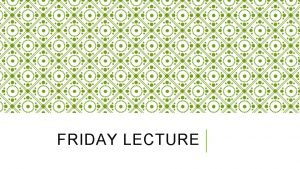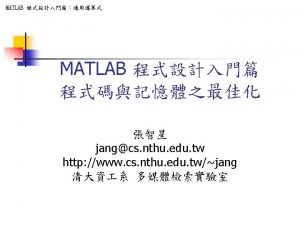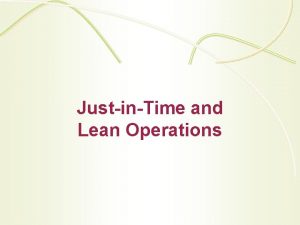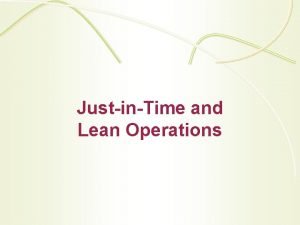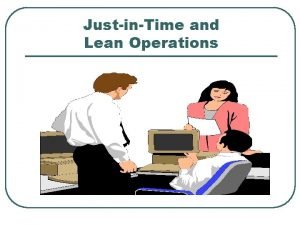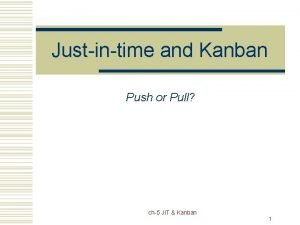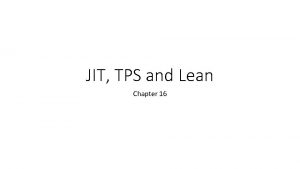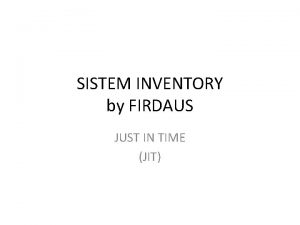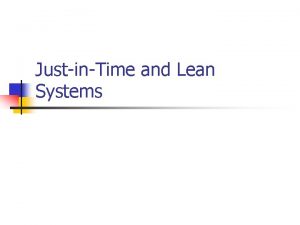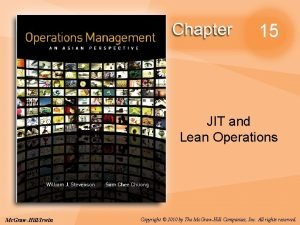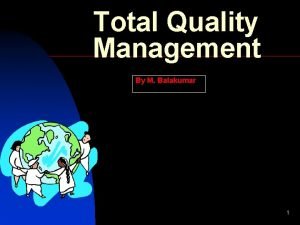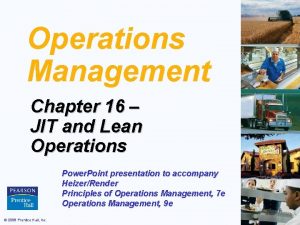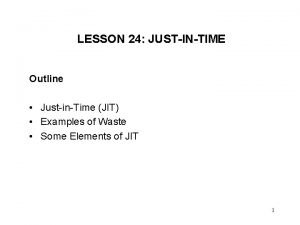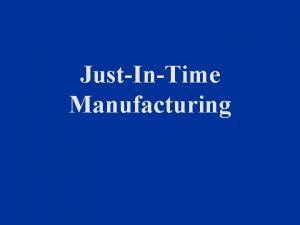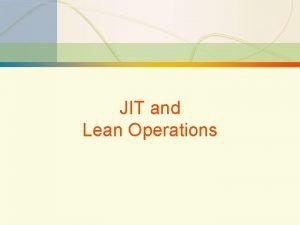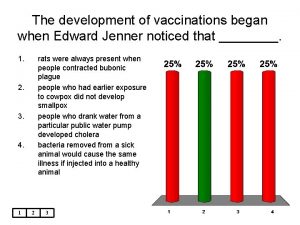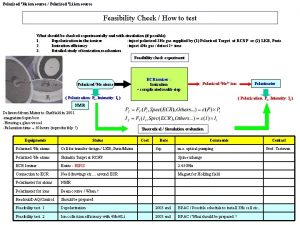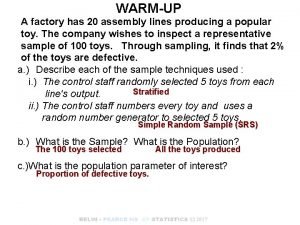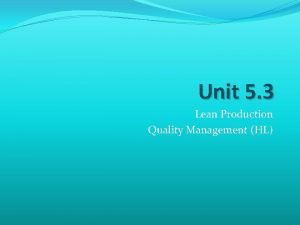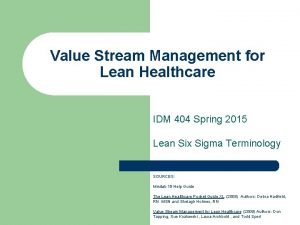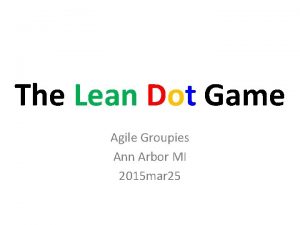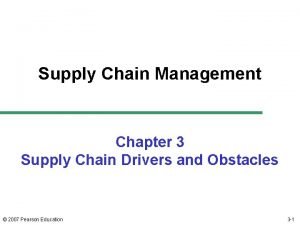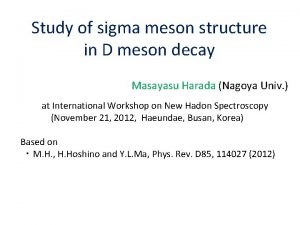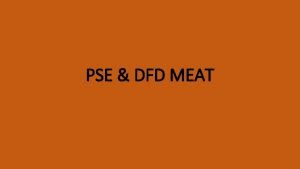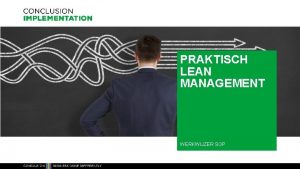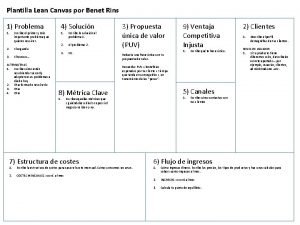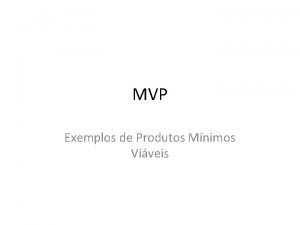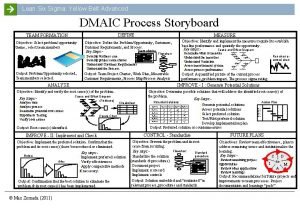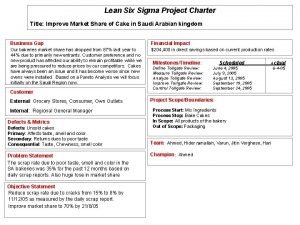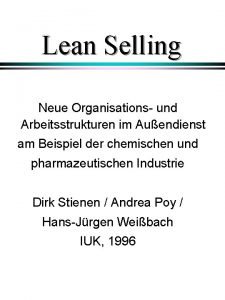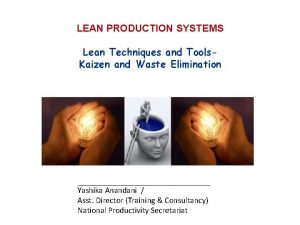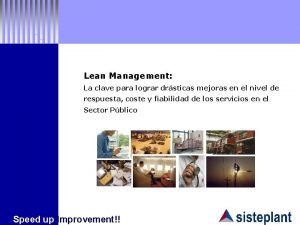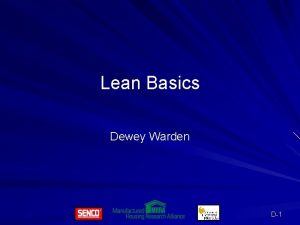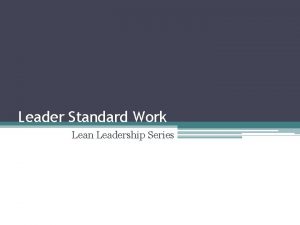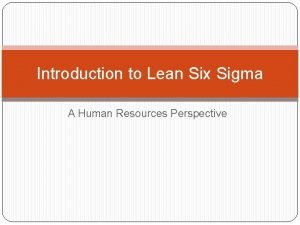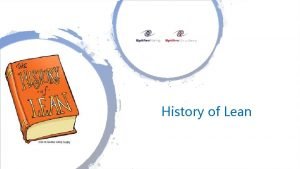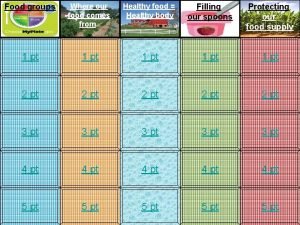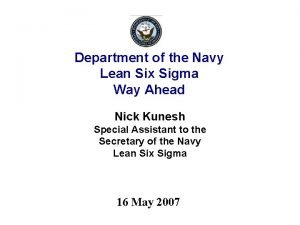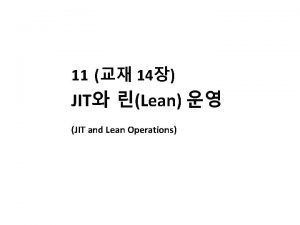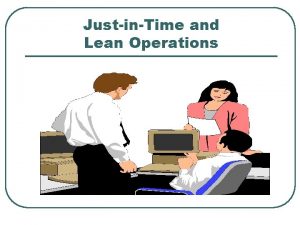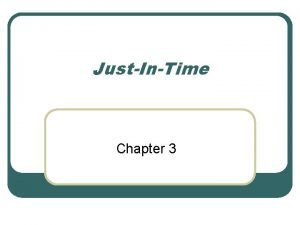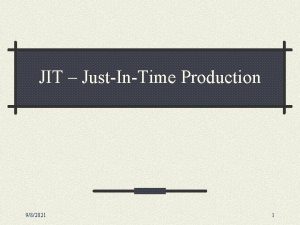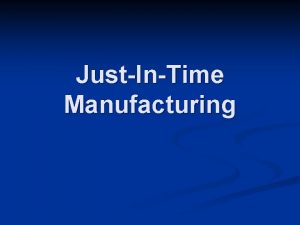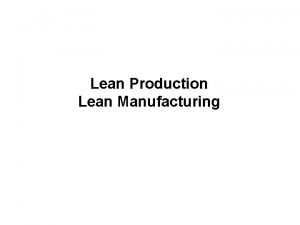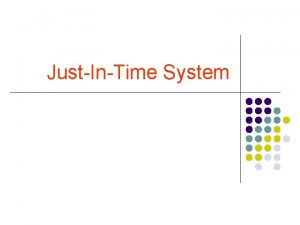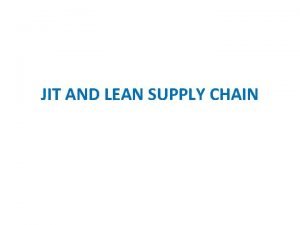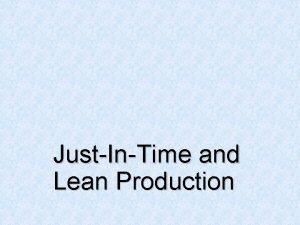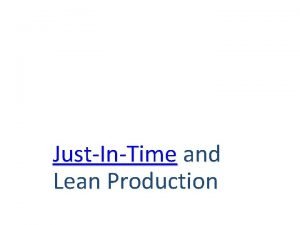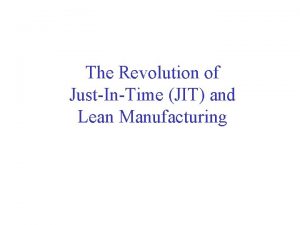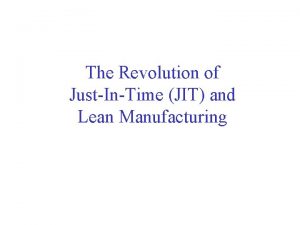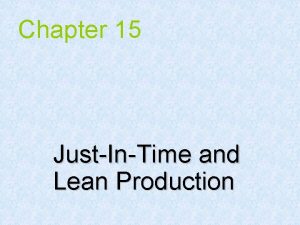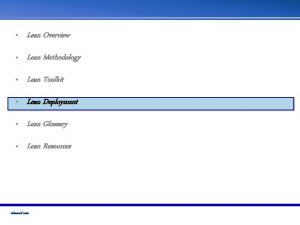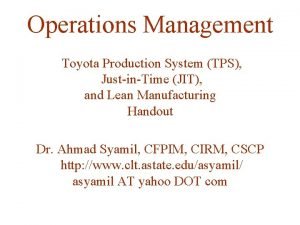JustinTime and Lean Operations What is JIT Producing


























































































- Slides: 90

Just-in-Time and Lean Operations

What is JIT ? ü Producing only what is needed, when it is needed (not early, not late; not less, not more) ü Achieving high volume production using minimal inventories ü An integrated but simplified system ü JIT’s mandate: Elimination of all waste in production effort

Just-in-Time Just-in-time (JIT): A highly coordinated processing system in which goods move through the system, and services are performed, just as they are needed ØSupplies and components are ‘pulled’ through the system to arrive where they are needed when they are needed (just-in-time) ØA management philosophy of continuous and forced problem solving by attacking the root causes

Lean Production ØJIT lean production ØLean Production supplies customers with exactly what the customer wants, when the customer wants, without waste, through continuous improvement ØJIT operates with very little fat

What Does Just-in-Time Do? Ø Attacks waste (anything not adding value to the product) Ø Achieves streamlined production by reducing inventory Ø Exposes problems and bottlenecks caused by variability

Goal of JIT The ultimate goal of JIT is a balanced system. (Achieves a smooth, rapid flow of materials through the system) The supporting goals are: Ø Eliminate disruptions Ø Make the system flexible Ø Eliminate waste, especially excess inventory

Summary: JIT Goals and Building Blocks Ultimate A Goal balanced rapid flow Supporting Goals Eliminate disruptions Make the system flexible Product Design Process Design Eliminate waste Personnel Elements Manufacturing Planning Building Blocks

Quotation by Shoichiro Toyoda Waste is ‘anything other than the minimum amount of equipment, materials, parts, space, and worker’s time, which are absolutely essential to add value to the product. ’ — Shoichiro Toyoda © 1995 Corel Corp.

Sources of Waste ØOverproduction ØWaiting ØUnnecessary transportation ØInventory ØInefficient work methods ØInefficient processing ØUnnecessary motions ØProduct defects

Waste in Operations (1 of 3)

Waste in Operations (2 of 3)

Waste in Operations (3 of 3)

JIT Reduced Waste at Hewlett-Packard Waste Reduction (%) Setup Time Scrap Finished Goods Inventory Space 20% 30% 40% Lead Time 50% Raw Material Inventory Work-in-Process Inventory 0% 50% 82% 20% 40% 60% 80% 100%

Kaizen Philosophy (1 of 3) ü Continuous improvement ü Requires total employee involvement ü Essence of JIT is willingness of workers to üSpot quality problems üHalt production when necessary üGenerate ideas for improvement üAnalyze problems

Kaizen Philosophy (2 of 3) ØWaste is the enemy ØImprovement should be done gradually and continuously ØEveryone should be involved ØBuilt on a cheap strategy ØCan be applied anywhere

Kaizen Philosophy (3 of 3) ØSupported by a visual system ØFocuses attention where value is created ØProcess oriented ØStresses main effort of improvement should come from new thinking and work style ØThe essence of organizational learning is to learn while doing

Big vs. Little JIT ØBig JIT – broad focus ØVendor relations ØHuman relations ØTechnology management ØMaterials and inventory management ØLittle JIT – narrow focus ØScheduling materials ØScheduling services for production

JIT Building Blocks In order to achieve competitive advantage through JIT, the necessary building blocks should be installed The building blocks can also be regarded as JIT success factors or the basic elements of JIT

JIT Building Blocks 1. Product design 2. Process design 3. Personnel/organizational elements 4. Manufacturing planning and control 5. Supplier relationships (supplier networks) 6. Preventive maintenance

JIT Building Blocks: 1. Product Design ØProcess design with product design ØStandard product configuration and standart parts ØReduced number of parts ØModular design ØConcurrent engineering ØHighly capable production systems

JIT Building Blocks: 2. Process Design Small lot sizes · Setup time reduction · Cellular layout (Manufacturing cells) · Reduced Inventories (Limited WIP) · Continuous quality improvement · Production flexibility (multifunctional workers, general purpose machines) · Balanced system · Fail-safe methods ·

Small-Lot Production ü Requires less space & capital investment ü Moves processes closer together ü Makes quality problems easier to detect ü Makes processes more dependent on each other

Small versus Large Lots JIT produces same amount in same time if setup times are lowered JIT Small Lots A A B B B C Time Small lots also increase flexibility to meet customer demands Large-Lot Approach A A B B B Time B B B C C

Comparison of Level and Large Lot Material-use Approaches

Benefits of Small Lot Sizes Reduces inventory Less rework Less storage space Problems are more apparent Increases flexibility Easier to balance operations

Single-Minute Exchange Single-minute exchange of die (SMED): A system for reducing changeover time · Categorize changeover activities · Internal – activities that can only be done while machine is stopped · External – activities that do not require stopping the machine ·

Layout ØJIT objective: Reduce movement of people and material ØMovement is waste! ØJIT requires work-cells for product families (group technology) Ømovable, changeable, flexible machinery Øshort distances Øhigh level of workplace organization and neatness Øreduced space for inventory

Cellular Layouts ü Group dissimilar machines in manufacturing cell to produce family of parts ü Work flows in one direction through cell ü Cycle time adjusted by changing worker paths ü Decreasing set-up times

Worker Routes Lengthened as Volume Decreases Cell 1 Cell 2 Worker 1 Worker 2 Worker 3 Cell 4 Cell 5

Layout Tactics Build work cells for families of products · Minimize distance · Design little space for inventory · Improve employee communication · Use poka-yoke devices · Build flexible or movable equipment · Cross train workers to add flexibility to layout ·

Quality Improvement (1 of 4) ØJIT exposes quality problems by reducing inventory ØJIT eliminates number defects with small lots ØJIT requires quality by suppliers ØTeam approach and continuous improvement are important for ensuring quality ØQuality is maintained by the following procedure: Find the root cause of the problem, solve

Quality Improvement (2 of 4) ØJIT requires TQM ØStatistical process control ØContinuous improvement ØWorker involvement & empowered employees ØInspect own work ØQuality circles ØImmediate feedback ØFailsafe methods such as poka-yoke (prevents defectives) ØQuality at the source

Quality Improvement (3 of 4) JIT requires 1) Quality within the firm · Autonomation (jidoka): automatic detection of defects during production 2) Quality by suppliers

Quality Improvement (4 of 4) ü Jidoka assures quality at the source ü Andon lights signal quality problems ü Visual control makes problems visible

Visual Control (1 of 3)

Visual Control (2 of 3)

Visual Control (3 of 3)

Production Flexibility · Overall objective is to achieve the ability to process a mix of products in a smooth flow. · Eliminate bottlenecks Reduce downtime by reducing changeover time · Use preventive maintenance to reduce breakdowns · Cross-train workers to help clear bottlenecks · Use many small units of capacity ·

A Balanced System Balanced system: Distributing the workload evenly among work stations · Work assigned to each work station must be less than or equal to the cycle time · Cycle time is set equal to the takt time · Takt time is the cycle time needed to match the pace of production to customer demand for final product ·

Streamlined Production Traditional Flow Suppliers Flow with JIT Suppliers Production Process (stream of water) Customers Inventory (stagnant ponds) Material (water in stream) Customers

Inventories Ø Traditional: inventory exists in case problems arise Ø JIT objective: eliminate inventory Ø JIT requires ØSmall lot sizes ØLow setup time ØContainers for fixed number of parts Ø JIT inventory: Minimum inventory (raw material, WIP and finished goods) to keep the system running

JIT Inventory Tactics ØUse a pull system to move inventory ØReduce lot size ØReduce setup time ØDevelop Just-in-Time delivery systems with suppliers ØDeliver directly to point of use ØPerform-to-schedule ØUse group technology

Limited Work in Process · Benefits Lower carrying costs · Less space · Increased flexibility · Aids scheduling · Saves cost of rework and scrap · · Two general approaches Kanban – focuses on individual work stations · Constant work in process (CONWIP) – focuses on the system as a whole ·

Inventory Hides Problems Just as Water in a Lake Hides Rocks Inventory level İnefficient layout Unreliab le supplier Bad design Process downti Setup Quality me time problem s Machine Late breakdown deliveries Scrap Process downti Setup Quality me time problem s Late deliveries

Lowering Inventory Reduces Waste Work in process inventory level (hides problems) Unreliable Vendors Scrap Capacity Imbalances

Lowering Inventory Reduces Waste Reducing inventory exposes problems so they can be solved. Unreliable Vendors WIP Scrap Capacity Imbalances

Lowering Inventory Reduces Waste Reducing inventory reveals problems so they can be solved. Unreliable Vendors Scrap WIP Capacity Imbalances

JIT Building Blocks: 3. Personnel/Organizational Elements · Workers as assets · Cross-trained workers · Employee empowerment · Continuous improvement · Cost accounting · Leadership/project management · Commitment

Employee Empowerment Employee empowerment · Empowered and cross-trained employees (to help clear bottlenecks) · Get employees involved in product & process (employees know the job best!) · Few job classifications to ensure flexibility of employees · Training support

Bottom-round Management Style & Commitment · Support of management, employees and suppliers Any improvement must be made in accordance with the scientific method, under the quidance of a teacher, at the lowest possible level in the organization (Toyota Production System’s

JIT Building Blocks: 4. Manufacturing Planning and Control · Uniform production levels · Level loading (level schedules) · Pull systems · Visual systems · Reduced transaction processing

Uniform Production ü Results from smoothing production requirements ü Kanban systems can handle +/- 10% demand changes ü Smooths demand across planning horizon ü Mixed-model assembly steadies component production

Level Schedules · · · Reduce ripple effect of small variations in schedules (e. g. , final assembly) Production quantities evenly distributed over time (e. g. , 7/day) Build same mix of products every day · · Results in many small lots Item Monthly Quantity Daily Quantity A 40 2

Mixed-Model Sequencing

JIT Scheduling Tactics Involves timing of operations Scheduling in JIT requires · Level loading (level schedules) · Zero deviation from schedules (performing to schedules) · Suppliers informed about schedules · Small lots (seeking one-piece-make and onepiece move) · Making each operation produce a perfect part · Kanban techniques

Pull/Push Systems ØPull system: System for moving work where a workstation pulls output from the preceding station just as it is needed. (e. g. Kanban) vs. ØPush system: System for moving work where output is pushed to the next station as it is completed

The Pull System ü Material is pulled through the system when needed ü Reversal of traditional push system where material is pushed according to a schedule ü Forces cooperation ü Prevent over and underproduction

Kanban Production Control System (1 of 2) ü Kanban: Card or other device that communicates demand for work or materials from the preceding station ü Japanese word meaning “signal” or “visible record” may be a card, or may be a flag, ball etc. ü Paperless production control system ü Kanban card indicates standard quantity of production

Kanban Production Control System (2 of 2) ü The kanban cards provide direct control (limit) on the amount of work-in-process between cells. ü Derived from two-bin inventory system ü Maintains discipline of pull production ü Signifies an authority to pull or produce which comes from a downstream process ü Production kanban authorizes production ü Withdrawal kanban authorizes movement of goods

A Sample Kanban

Determination of the Number of Kanbans Needed ØSetting up a kanban system requires determining the number of kanbans (or containers) needed. ØEach container represents the minimum production lot size ØAn accurate estimate of lead time required to produce a container is key to determining how many kanbans are required

Determination of the Number of Kanbans Kanban Formula N DT(1+X) = C N = Total number of containers D = Planned usage rate of using work center T = Average waiting time for replenishment of parts plus average production time for a container of parts X = Policy variable set by management - possible inefficiency in the system C = Capacity of a standard container

Here the customer starts the process, pulling an inventory item from Final Assembly… Then sub-assembly work is pulled forward by that demand… Customers JIT Demand-Pull Logic Vendor Fab Vendor Sub Final Assembly The process continues throughout the entire production process and supply chain Fab Sub

Kanban Signals “Pull” Material Through the Process Once the Production kanban is received, the Machine Center produces a unit to replace the one taken by the Assembly Line people in the first place Machine Center Withdrawal kanban Storage Part A Production kanban The process begins by the Assembly Line people pulling Part A from Storage Part A This puts the system back where it was before the item was pulled Assembly Line Material Flow Card (signal) Flow

JIT Building Blocks: 5. Supplier Relationships Ø Reduced number of vendors Ø Supportive supplier relationships Ø Quality deliveries on time Ø Frequent deliveries in small lot quantities Ø Reduced lead times Ø Reduced transaction processing Ø Certified vendors

Suppliers Ø JIT partnerships are formed Ø JIT partnerships eliminate: ØSome unnecessary activities ØIn-plant inventory ØIn-transit inventory ØPoor suppliers

ØFew Characteristics of JIT Partnerships Suppliers ØNearby ØLong-term relationships ØAnalysis and support to enable desirable suppliers to become or stay price competitive ØBuyer resists vertical integration and subsequent wipeout of supplier business ØSuppliers encouraged to extend JIT to their suppliers (2 nd and 3 rd tier suppliers)

Traditional Supplier Network Buyer Supplier Supplier

Tiered Supplier Network Buyer First Tier Supplier Second Tier Supplier Third Tier Supplier Supplier

JIT Building Blocks: 6. Preventive Maintenance ØAll activities involved in keeping equipment in working order ØMaintaining equipment in good condition and replacing parts that have a tendency to fail before they actually fail ØDone to prevent failure ØJIT requires ØScheduled & daily PM ØOperator involvement in PM ØKnows machines ØResponsible for product quality

Total Productive Maintenance (TPM) ü Breakdown maintenance üRepairs to make failed machine operational ü Preventive maintenance üSystem of periodic inspection & maintenance to keep machines operating ü TPM combines preventive maintenance & total quality concepts

TPM Requires Management to: ü Design products that can be easily produced on existing machines ü Design machines for easier operation, changeover, maintenance ü Train & retrain workers to operate machines ü Purchase machines that maximize productive potential ü Design preventive maintenance plan spanning life of machine

Housekeeping: Maintaining a workplace that is clean and free of unnecessary materials. Housekeeping 5 S’s § Sort § Straighten § Sweep § Standardize § Self-discipline

Results ØQueue and delay reduction, speedier throughput, freed assets, and winning orders ØQuality improvement, reduces waste and wins orders ØCost reduction increases margin or reduces selling price ØVariability reductions in the workplace reduces waste and wins orders ØRework reduction, reduces waste and wins

Yielding Faster response to the customer at lower cost and higher quality A competitive advantage!

Summary: Just-In-Time Production WHAT IT IS • Management philosophy • “Pull” system though the plant WHAT IT REQUIRES • Employee participation • • Industrial engineering/basics Continuing improvement Total quality control Small lot sizes WHAT IT DOES • Attacks waste • Exposes problems and bottlenecks • Achieves streamlined production WHAT IT ASSUMES • Stable environment

Comparison of JIT and Traditional Systems Factor Traditional JIT Inventory Much to offset forecast errors, late deliveries Minimal necessary to operate Deliveries Few, large Many, small Lot sizes Large Small Setup; runs Few, long runs Many, short runs Vendors Long-term relationships are unusual Partners Workers Necessary to do the work Assets

Transitioning to a JIT System ØGet top management commitment ØDecide which parts need most effort ØObtain support of workers ØStart by trying to reduce setup times ØGradually convert operations ØConvert suppliers to JIT ØPrepare for obstacles

Obstacles to Conversion ØManagement may not be committed ØWorkers/management may not be cooperative ØMay be difficult to change company culture ØSuppliers may resist Ø Why?

Suppliers May Resist JIT ØUnwilling to commit resources ØUneasy about long-term commitments ØFrequent, small deliveries may be difficult ØBurden of quality control shifts to supplier ØFrequent engineering changes may cause JIT changes

Benefits of JIT 1. 2. 3. 4. 5. 6. 7. 8. Reduced inventory Improved quality Lower costs Reduced space requirements Reduced lead times Increased productivity Greater flexibility Reduced scrap and rework 8. Better relations with suppliers 9. Simplified scheduling and control activities 10. Increased capacity 11. Increased equipment utilization 12. Better use of human resources 13. More product variety 14. Reduced need for indirect labor

JIT in Services (1 of 3) The basic goal of the demand flow technology in the service organization is to provide optimum response to the customer with the highest quality service and lowest possible cost.

JIT in Services (2 of 3) All the techniques used in manufacturing are used in services ØLevel the facility load & eliminate disruptions and unnecessary activities ØReorganize physical configuration ØIntroduce demand-pull scheduling ØDevelop supplier networks ØMinimize WIP

JIT in Services (3 of 3) All the techniques used in manufacturing are used in services ØMake the system flexible ØReduce setup and lead times ØEliminate waste ØSimplify the process ØOrganize problem solving groups ØUpgrade quality

JIT II: a supplier representative works right in the company’s plant, making sure there is an appropriate supply on hand.

JIT Implementation ü Use JIT to finely tune an operating system ü Somewhat different in USA than Japan ü JIT is still evolving ü JIT isn’t for everyone

Elements of JIT (1 of 2) ØSmooth flow of work (the ultimate goal) ØElimination of waste ØContinuous improvement ØEliminating anything that does not add value ØSimple systems that are easy to manage ØUse of product layouts to minimize moving materials and parts ØQuality at the source

Elements of JIT (2 of 2) ØPoka-yoke – fail safe tools and methods ØPreventative maintenance ØGood housekeeping ØSet-up time reduction ØCross-trained employees ØA pull system

Attributes of Lean Producers - They Øuse JIT to eliminate virtually all inventory Øbuild systems to help employees produce a perfect part every time Øreduce space requirements Ødevelop close relationships with suppliers Øeducate suppliers

Attributes of Lean Producers - They Øeliminate all but value-added activities Ødevelop the workforce Ømake jobs more challenging Øreduce the number of job classes and build worker flexibility
 Jit lean manufacturing
Jit lean manufacturing Jit tps and lean operations
Jit tps and lean operations Justintime production
Justintime production Jit operations management
Jit operations management Jit operations management
Jit operations management Lean systems operations management
Lean systems operations management Building blocks of jit
Building blocks of jit Lean systems operations management
Lean systems operations management Lean systems operations management
Lean systems operations management A production kanban authorizes a worker to:
A production kanban authorizes a worker to: In the lean philosophy, the ideal lot size is
In the lean philosophy, the ideal lot size is Lean systems operations management
Lean systems operations management What is process management in tqm
What is process management in tqm Warp jit service
Warp jit service Estructura organizacional por tpm
Estructura organizacional por tpm Just in time approach
Just in time approach Jit approach
Jit approach Jit philosophy
Jit philosophy Vectorizing matlab
Vectorizing matlab What is jit
What is jit Building blocks of jit
Building blocks of jit What is jit
What is jit Kanban push pull
Kanban push pull Jit layout tactics
Jit layout tactics Just intime
Just intime Kelemahan jit
Kelemahan jit Philosophy of jit
Philosophy of jit Jit building blocks
Jit building blocks Kim hazelwood
Kim hazelwood Jit balakumar
Jit balakumar Jit layout tactics
Jit layout tactics Jit layout tactics
Jit layout tactics Jit examples
Jit examples Just-in-time production
Just-in-time production Jit inventory
Jit inventory Directions for producing mhcs come from
Directions for producing mhcs come from An ion source is producing 6li ions
An ion source is producing 6li ions Factor relating questions in research examples
Factor relating questions in research examples A factory has 20 assembly lines producing
A factory has 20 assembly lines producing Kumar is producing the photoelectric effect by using
Kumar is producing the photoelectric effect by using Process specification example
Process specification example A goal of producing process specifications is to:
A goal of producing process specifications is to: Seeded vascular plants
Seeded vascular plants Producing for dummies
Producing for dummies Gametophytes have gamete-producing organs called _____.
Gametophytes have gamete-producing organs called _____. A farmer wanted to rid his apple
A farmer wanted to rid his apple A goal of producing process specifications is to:
A goal of producing process specifications is to: Structured decision in system analysis and design
Structured decision in system analysis and design Fixed asset write off
Fixed asset write off Lean production and quality management
Lean production and quality management When is the longest day of the year
When is the longest day of the year Value stream management for lean healthcare
Value stream management for lean healthcare Cohort analysis lean startup
Cohort analysis lean startup Le dot game
Le dot game Chapter 3 supply chain drivers and metrics
Chapter 3 supply chain drivers and metrics Lean meson
Lean meson A socratic approach to lean six sigma
A socratic approach to lean six sigma Lean six sigma forum
Lean six sigma forum Sigma gamma rho march of dimes
Sigma gamma rho march of dimes Filler slab roofs advantages
Filler slab roofs advantages Silma
Silma Pse meaning in lean
Pse meaning in lean Lean temple
Lean temple Lean sop template
Lean sop template Canvas de problema
Canvas de problema Viveis
Viveis Alt asm lean framework
Alt asm lean framework Lura lean
Lura lean Lean warehousing principles
Lean warehousing principles Yellow belt dmaic
Yellow belt dmaic 6 sigma project charter
6 sigma project charter Lean selling
Lean selling Poka yoke
Poka yoke What is lean synchronization
What is lean synchronization Trs lean
Trs lean Dynamics 365 lean manufacturing
Dynamics 365 lean manufacturing Drstico
Drstico Lean sensei définition
Lean sensei définition Pdvsm
Pdvsm Subbase
Subbase Key metrics in business model canvas
Key metrics in business model canvas Dewey lean
Dewey lean Lsw leader standard work
Lsw leader standard work Six sigma human resources
Six sigma human resources Conclusion lean manufacturing
Conclusion lean manufacturing O'donoghue maneuver
O'donoghue maneuver Lean analytics stages
Lean analytics stages Eli lean
Eli lean Lean meat sample
Lean meat sample Navy lean six sigma
Navy lean six sigma Lean discovery
Lean discovery
